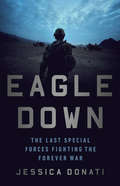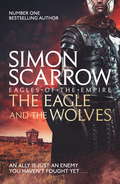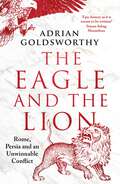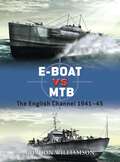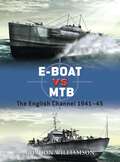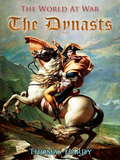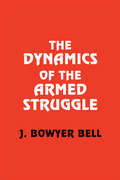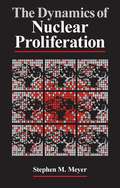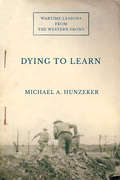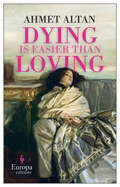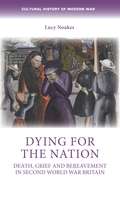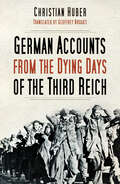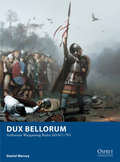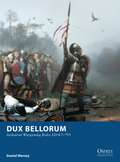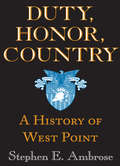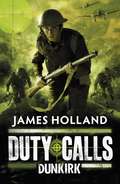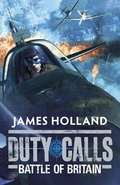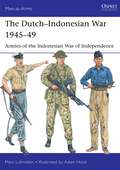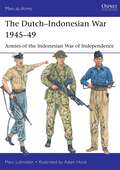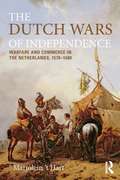- Table View
- List View
Eagle Down: The Last Special Forces Fighting the Forever War
by Jessica DonatiSelected as a "BUZZ BOOK" for Fall/Winter (Publishers Lunch) &“Afghanistan is one of the most dangerous countries in the world, and U.S. Special Forces are one of the most secretive groups in America's military. That Jessica Donati managed to crack both and write a book that is both brutally honest and deeply compassionate about this elite group is a journalistic triumph. It is beautifully written, impossible to put down and deeply terrifying for anyone who has worked in that country. She's one of those writers who makes me deeply proud of my profession.&”―Sebastian Junger, New York Times best-selling authorIn 2015, the White House claimed triumphantly that &“the longest war in American history&” was over. But for some, it was just the beginning of a new war, fought by Special Operations Forces, with limited resources, little governmental oversight, and contradictory orders. With big picture insight and on-the-ground grit, Jessica Donati shares the stories of the impossible choices these soldiers must make. After the fall of a major city to the Taliban that year, Hutch, a battle-worn Green Beret on his fifth combat tour was ordered on a secret mission to recapture it and inadvertently called in an airstrike on a Doctors Without Borders hospital, killing dozens. Caleb stepped on a bomb during a mission in notorious Sangin. Andy was trapped with his team during a raid with a crashed Black Hawk and no air support. Through successive policy directives under the Obama and Trump administrations, America has come to rely almost entirely on US Special Forces, and without a long-term plan, is failing to stabilize Afghanistan, undermining US interests both at home and abroad. Eagle Down is a riveting account of the heroism, sacrifice, and tragedy experienced by those that continue to fight America&’s longest war.
The Eagle and the Wolves: Cato & Macro: Book 4 (Eagle #19)
by Simon ScarrowIF YOU DON'T KNOW SIMON SCARROW, YOU DON'T KNOW ROME!THE EAGLE AND THE WOLVES is the gripping fourth novel in Simon Scarrow's bestselling Eagles of the Empire series. Perfect for fans of Bernard Cornwell and Conn Iggulden. 'A new book in Simon Scarrow's long-running series about the Roman army is always a joy' The TimesBritannia, AD 44. Occupation is never easy. The enemy is butchering their supply convoys, their garrison town is starving and the truce with the locals is uneasy at best. Young Cato, newly promoted, and veteran centurion Macro are ordered to train the Wolves and the Boars, two cohorts of barbarian Britons, and introduce them to the brutal drills of the Roman Imperial Army. Macro is confident they'll win the natives over, but Cato worries about putting weapons into the hands of potential rebels.Ultimately, only one thing matters: is there a difference between the enemy at their gates, and the allies in their own camp?
The Eagle and the Lion: Rome, Persia and an Unwinnable Conflict
by Adrian GoldsworthyThe epic story of the imperial rivalry between two of the greatest empires of the ancient world – Parthian and Persian – and how they rose and eventually fell.The Roman empire shaped the culture of the western world against which all other great powers are compared. Stretching from the north of Britain to the Sahara, and from the Atlantic coast to the Euphrates, it imposed peace and prosperity on an unprecedented scale.However, the exception lay in the east, where the Parthian and then Persian empires ruled over great cities and the trade routes to mysterious lands beyond. This was the place Alexander the Great had swept through, creating a dream of glory and conquest which tantalised Greeks and Romans alike. Caesar, Mark Antony and a long succession of emperors longed to follow in Alexander's footsteps. All failed. Only here did the Roman empire slow down and eventually stop, unable to go any further.Following seven centuries of conflict that, ultimately, neither Rome nor Persia would win, The Eagle and the Lion delves into the clash, context and journeys of these entities of great power and the people caught in their wider struggle.
E-Boat vs MTB: The English Channel 1941–45 (Duel)
by Gordon WilliamsonAn examination of the 'small boat' war between the Germans and the British in the English Channel.During the Second World War, German E-Boats were so active in the English Channel that the narrow stretch of water became known as 'E-Boat Alley'. To counter the threat of these E-Boats, Britain brought its coastal forces to bear – flotillas of small Motor Torpedo and Gun Boats (MTBs and MGBs) and Motor Launches (MLs). As the Germans sought to maintain their supremacy in Channel waters, they continued to develop their E-Boat designs to accommodate more armor and more firepower. Rather than matching the newer E-Boats for armament, the British developed several types to fulfill the varied roles for which the Kriegsmarine were attempting to use the E-Boat. Illustrated with high-quality photographs and battlescene artworks, this book details this developing conflict, examining the evolution of the boats involved, and covering their battles from fights in the Thames Estuary to the build-up for D-Day.
E-Boat vs MTB: The English Channel 1941–45 (Duel)
by Gordon WilliamsonAn examination of the 'small boat' war between the Germans and the British in the English Channel.During the Second World War, German E-Boats were so active in the English Channel that the narrow stretch of water became known as 'E-Boat Alley'. To counter the threat of these E-Boats, Britain brought its coastal forces to bear – flotillas of small Motor Torpedo and Gun Boats (MTBs and MGBs) and Motor Launches (MLs). As the Germans sought to maintain their supremacy in Channel waters, they continued to develop their E-Boat designs to accommodate more armor and more firepower. Rather than matching the newer E-Boats for armament, the British developed several types to fulfill the varied roles for which the Kriegsmarine were attempting to use the E-Boat. Illustrated with high-quality photographs and battlescene artworks, this book details this developing conflict, examining the evolution of the boats involved, and covering their battles from fights in the Thames Estuary to the build-up for D-Day.
The Dynasts
by Thomas Hardy"The Dynasts" is an English-language drama in verse by Thomas Hardy. Hardy himself described this work as "an epic-drama of the war with Napoleon, in three parts, nineteen acts and one hundred and thirty scenes". Not counting the Forescene and the Afterscene, the exact total number of scenes is 131. The three parts were published in 1904, 1906 and 1908. Because of the ambition and scale of the work, Hardy acknowledged that The Dynasts was not a work that could be conventionally staged in the theatre, and described the work as "the longest English drama in existence". Scholars have noted that Hardy remembered war stories of the veterans of the Napoleonic wars in his youth, and used them as partial inspiration for writing The Dynasts many years later in his own old age. In addition, Hardy was a distant relative of Captain Thomas Hardy, who had served with Admiral Horatio Nelson at Trafalgar. Hardy consulted a number of histories and also visited Waterloo, Belgium, as part of his research. George Orwell wrote that Hardy had "set free his genius" by writing this drama and thought its main appeal was "in the grandiose and rather evil vision of armies marching and counter-marching through the mists, and men dying by hundreds of thousands in the Russian snows, and all for absolutely nothing."
The Dynamics of the Armed Struggle
by J. Bowyer BellThis is an analysis of one of the most prevalent forms of political violence at the end of the millennium. The author has been shot at, kidnapped, expelled and questioned in wars from Central America to Northern Ireland. The book reflects his access to the cultures of political violence.
The Dynamics of the Armed Struggle
by J. Bowyer BellThis is an analysis of one of the most prevalent forms of political violence at the end of the millennium. The author has been shot at, kidnapped, expelled and questioned in wars from Central America to Northern Ireland. The book reflects his access to the cultures of political violence.
The Dynamics of Nuclear Proliferation
by Stephen M. MeyerStephen M. Meyer steps back from the emotions and rhetoric surrounding the nuclear arms debates to provide a systematic examination of the underlying determinants of nuclear weapons proliferation. Looking at current theories of nuclear proliferation, he asks: Must a nation that acquires the technical capability to manufacture nuclear weapons eventually do so? In an analysis, remarkable for its rigor and accessibility, Meyer provides the first empirical, statistical model explaining why particular countries became nuclear powers when they did. His findings clearly contradict the notion that the pace of nuclear proliferation is controlled by a technological imperative and show that political and military factors account for the past decisions of nations to acquire or forgo the development of nuclear weapons.
The Dynamics of Coalition Naval Warfare: The Special Relationship at Sea (Corbett Centre for Maritime Policy Studies Series)
by Steven PagetThis book examines the dynamics of coalition naval operations. Since the end of the Second World War, few nations possess the capacity for large scale, sustained and independent naval operations; and even those that do, such as the USA, often find it economically, militarily and politically expedient to act multilaterally. As such, coalition naval operations increasingly became the norm throughout the twentieth-century, and there is little sign of this abating in the twenty-first. Multinational operations provide a number of benefits, but they also present a number of challenges. Examining the dynamics of coalition operations involving the Royal Navy (RN), Royal Australian Navy (RAN) and the United States Navy (USN) during the Korean War, Vietnam War and the Iraq War, this book provides a broad overview of naval interoperability between the three navies. Using the naval gunfire support (NGS) capability as a lens through which to analyse operations, the study explores a diverse range of issues, including: command and control, communications, equipment standardisation, intelligence, logistics, planning, rules of engagement, tactics, techniques and procedures and training. Approaching the subject through both historical and contemporary perspectives not only provides a unique assessment of the variation in the effectiveness of interoperability over time, but also offers a platform for better understanding and enhancing the performance of future coalition naval operations. Based on extensive archival research in Australia, the UK and the US, as well as wide-ranging interviews, this book sheds new light on the dynamics of conducting coalition operations. This book will be of great interest to students of naval history, strategic studies, sea power, maritime security, military studies, and IR in general.
The Dynamics of Coalition Naval Warfare: The Special Relationship at Sea (Corbett Centre for Maritime Policy Studies Series)
by Steven PagetThis book examines the dynamics of coalition naval operations. Since the end of the Second World War, few nations possess the capacity for large scale, sustained and independent naval operations; and even those that do, such as the USA, often find it economically, militarily and politically expedient to act multilaterally. As such, coalition naval operations increasingly became the norm throughout the twentieth-century, and there is little sign of this abating in the twenty-first. Multinational operations provide a number of benefits, but they also present a number of challenges. Examining the dynamics of coalition operations involving the Royal Navy (RN), Royal Australian Navy (RAN) and the United States Navy (USN) during the Korean War, Vietnam War and the Iraq War, this book provides a broad overview of naval interoperability between the three navies. Using the naval gunfire support (NGS) capability as a lens through which to analyse operations, the study explores a diverse range of issues, including: command and control, communications, equipment standardisation, intelligence, logistics, planning, rules of engagement, tactics, techniques and procedures and training. Approaching the subject through both historical and contemporary perspectives not only provides a unique assessment of the variation in the effectiveness of interoperability over time, but also offers a platform for better understanding and enhancing the performance of future coalition naval operations. Based on extensive archival research in Australia, the UK and the US, as well as wide-ranging interviews, this book sheds new light on the dynamics of conducting coalition operations. This book will be of great interest to students of naval history, strategic studies, sea power, maritime security, military studies, and IR in general.
Dying to Learn: Wartime Lessons from the Western Front (Cornell Studies in Security Affairs)
by Michael A. HunzekerIn Dying to Learn, Michael Hunzeker develops a novel theory to explain how wartime militaries learn. He focuses on the Western Front, which witnessed three great-power armies struggle to cope with deadlock throughout the First World War, as the British, French, and German armies all pursued the same solutions-assault tactics, combined arms, and elastic defense in depth. By the end of the war, only the German army managed to develop and implement a set of revolutionary offensive, defensive, and combined arms doctrines that in hindsight represented the best way to fight.Hunzeker identifies three organizational variables that determine how fighting militaries generate new ideas, distinguish good ones from bad ones, and implement the best of them across the entire organization. These factors are: the degree to which leadership delegates authority on the battlefield; how effectively the organization retains control over soldier and officer training; and whether or not the military possesses an independent doctrinal assessment mechanism.Through careful study of the British, French, and German experiences in the First World War, Dying to Learn provides a model that shows how a resolute focus on analysis, command, and training can help prepare modern militaries for adapting amidst high-intensity warfare in an age of revolutionary technological change.
Dying is Easier than Loving (The Ottoman Quartet #3)
by Ahmet Altan“A deeply compelling and immersive narrative about love, desire, loneliness and landscape.”—Elif Shafak (on book 1 of the series) “Altan uses a Tolstoyan combination of the epic and the intimate to explore questions of national identity and historical narrative.”—The Observer “Altan’s descriptions of a stifling atmosphere of authoritarian repression in Istanbul in the early 1900s conjure up constant comparisons with today’s Turkey.”—The TLS The third book in the Ottoman Quartet, set in the years leading up to WWI, is steeped in the tumultuous events and the political struggle that shaped 20th century Turkey, from the war against the Bulgarian army and the coup that resulted in the nation’s one-party rule. Against this background, a tormented, obsessive love affair unfolds between Nizam, the son of Hikmet Bey, and Russian pianist Anya. This tapestry of love and war allows Altan to analyse the structure of male power and its degeneration into violence against women, uncompromising nationalism, and pervasive censorship. Atan confirms himself as a caustic, courageous writer, never afraid to denounce an arrogant and undemocratic power, allowing the reader to read between the lines the situation of contemporary Turkey.
Dying for the nation: Death, grief and bereavement in Second World War Britain (Cultural History of Modern War)
by Lucy NoakesDeath in war matters. It matters to the individual, threatened with their own death, or the death of loved ones. It matters to groups and communities who have to find ways to manage death, to support the bereaved and to dispose of bodies amidst the confusion of conflict. It matters to the state, which has to find ways of coping with mass death that convey a sense of gratitude and respect for the sacrifice of both the victims of war, and those that mourn in their wake. This social and cultural history of Britain in the Second World War places death at the heart of our understanding of the British experience of conflict. Drawing on a range of material, Dying for the nation demonstrates just how much death matters in wartime and examines the experience, management and memory of death. The book will appeal to anyone with an interest in the social and cultural history of Britain in the Second World War.
Dying for the nation: Death, grief and bereavement in Second World War Britain (Cultural History of Modern War)
by Lucy NoakesDeath in war matters. It matters to the individual, threatened with their own death, or the death of loved ones. It matters to groups and communities who have to find ways to manage death, to support the bereaved and to dispose of bodies amidst the confusion of conflict. It matters to the state, which has to find ways of coping with mass death that convey a sense of gratitude and respect for the sacrifice of both the victims of war, and those that mourn in their wake. This social and cultural history of Britain in the Second World War places death at the heart of our understanding of the British experience of conflict. Drawing on a range of material, Dying for the nation demonstrates just how much death matters in wartime and examines the experience, management and memory of death. The book will appeal to anyone with an interest in the social and cultural history of Britain in the Second World War.
The Dying Days of the Third Reich: German Accounts from World War II
by Christian HuberIt has taken seventy years for the accounts of ordinary German soldiers during the Second World War to be made widely available to an English-speaking audience. This is hardly surprising given that interest in these important documents has only recently surfaced in Germany, where a long process of coming to terms with the past, or Vergangenheitsbewältigung, has taken place. Unlike other historical depictions of the fall of the Third Reich, Dying Days of the Third Reich presents the authentic voices of those German soldiers who fought on the front line. Throughout we are witness to the kind of bravery, ingenuity and, ultimately, fear that we are so familiar with from the many Allied accounts of this time. Their sense of confusion and terror is palpable as Nazi Germany finally collapses in May 1945, with soldiers fleeing to the American victors instead of the Russians in the hope of obtaining better treatments as a prisoner of war. This collection of first-hand accounts includes the stories of German soldiers fighting the Red Army on the Eastern Front; of Horst Messer, who served on the last East Prussian panzer tank but was captured and spent four years in Russian captivity at Riga; Hans Obermeier, who recounts his capture on the Czech front and escape from Siberia; and a moving account of an anonymous Wehrmacht soldier in Slovakia given orders to execute Russian prisoners.
Dux Bellorum: Arthurian Wargaming Rules AD367–793 (Osprey Wargames #1)
by Daniel Mersey José Daniel PeñaThe Dark Age of Britain, from the middle of the 4th century to the end of the 8th, was a time of violence and warfare, when charismatic warlords such as the fabled King Arthur could gather together armies and carve out their own kingdoms. With this new set of wargames rules, players can take on the role of these warlords and command their own armies on the tabletop. Written by the author of the popular Glutter of Ravens rules set, Dux Bellorum is an element-based system, where each base of figures represents 50 fighting men. Each player has a specific number of points with which to construct his force and can choose a Late Roman, Romano-British, Welsh, Saxon, Pictish, Irish, or Sea Raider army, amongst others. The game is then played out following a set of simple, fast-paced rules. A completely self-contained gaming system, Dux Bellorum is perfect for gamers who are looking for a way into fighting Dark Age battles without investing a lot of time or money in larger rulesets.
Dux Bellorum: Arthurian Wargaming Rules AD367–793 (Osprey Wargames)
by Daniel Mersey José Daniel PeñaThe Dark Age of Britain, from the middle of the 4th century to the end of the 8th, was a time of violence and warfare, when charismatic warlords such as the fabled King Arthur could gather together armies and carve out their own kingdoms. With this new set of wargames rules, players can take on the role of these warlords and command their own armies on the tabletop. Written by the author of the popular Glutter of Ravens rules set, Dux Bellorum is an element-based system, where each base of figures represents 50 fighting men. Each player has a specific number of points with which to construct his force and can choose a Late Roman, Romano-British, Welsh, Saxon, Pictish, Irish, or Sea Raider army, amongst others. The game is then played out following a set of simple, fast-paced rules. A completely self-contained gaming system, Dux Bellorum is perfect for gamers who are looking for a way into fighting Dark Age battles without investing a lot of time or money in larger rulesets.
Duty, Honor, Country: A History of West Point
by Stephen E. AmbroseThis new paperback edition of Stephen E. Ambrose's highly regarded history of the United States Military Academy features the original foreword by Dwight D. Eisenhower and a new afterword by former West Point superintendent Andrew J. Goodpaster.
Duty Calls: Dunkirk (Duty Calls)
by James Holland'YOU WANTED TO SEE SOME ACTION - WELL YOU'RE GOING TO GET IT NOW. YOU'RE GOING TO GET IT NOW ALL RIGHT.'Friday 24th May, 1940Private Johnny Hawke, aged sixteen, awakens to artillery fire.Hours later, Stukas scream down from the sky. Messerschmit fighters roar towards his regiment. Trucks burst into flames.Now men and mules lay dead and dying, severed limbs twisted grotesquely as blood soaks the cobbled streets.Young Private Hawke just wants to do his duty and serve his country. But as he - and his fellow soldiers - prepare to stop the German advance, there's only one question on everyone's lips.HOW WILL THEY SURVIVE?
Duty Calls: World War 2 Fiction (Duty Calls)
by James HollandPilot officer Archie Jackson, 19, is in control of the RAF's newest fighter aircraft, a Supermarine Spitfire.Now he has the Luftwaffe in his sights and only one thing matters: defending Britain. Suddenly planes are falling from the sky, exploding and spiralling into the English Channel.France has fallen and the swastika flies over Occupied Europe. Only these young pilots - barely out of boyhood - stand between Britain and a Nazi invasion . . . Duty Calls: Battle of Britain, throws you deep into the heart - and horror - of Britain's darkest, and finest, hour.** Historian James Holland is the bestselling author of the Jack Tanner adult war fiction books. Duty Calls is his first series for younger readers, and showcases his expertise on the Second World War. ** James Holland presented Battle of Britain: The Real Story on BBC2.
The Dutch–Indonesian War 1945–49: Armies of the Indonesian War of Independence (Men-at-Arms)
by Marc LohnsteinHighly detailed and colourful, this account illustrates the struggle of Indonesian forces in their War of Independence against the Netherlands, following the surrender of occupying Japanese forces in 1945.Following on from MAA 521 Royal Netherlands East Indies Army 1936–42 and completing the coverage of the post-World War II wars of decolonization, The Dutch–Indonesian War 1945–49 describes the Japanese surrender in September 1945 which left a power vacuum in the colonial Dutch East Indies (Indonesia). Using vivid colour illustrations and rare photos, this title depicts the various forces involved in the struggle for Indonesia: the British Indian Army troops sent to key areas to disarm Japanese garrisons, the Indonesian nationalists who immediately proclaimed an independent Republic, remaining Japanese troops, and the Dutch forces which arrived in 1946.The wide dispersion of populations, and their ethnic, religious and political differences ensured that the struggle which followed was complex. Fragmented bands of nationalist permuda insurgents were slowly brought together under command of a republican army (the BKR, later TKR, and finally the TNI, complete with naval and air elements), but stubborn negotiations alternated with bouts of major fighting. This book details how the nationalists were defeated by Dutch and Dutch-led local forces in urban areas (e.g. during Operations Product and Crow, 1947 and 1948), but how their guerrillas evaded Dutch troops in the jungle hills and swamps. Illustrating a wide range of uniforms, insignia, personal weapons and equipment, this study showcases the troops and armour involved in the conflict.
The Dutch–Indonesian War 1945–49: Armies of the Indonesian War of Independence (Men-at-Arms)
by Marc LohnsteinHighly detailed and colourful, this account illustrates the struggle of Indonesian forces in their War of Independence against the Netherlands, following the surrender of occupying Japanese forces in 1945.Following on from MAA 521 Royal Netherlands East Indies Army 1936–42 and completing the coverage of the post-World War II wars of decolonization, The Dutch–Indonesian War 1945–49 describes the Japanese surrender in September 1945 which left a power vacuum in the colonial Dutch East Indies (Indonesia). Using vivid colour illustrations and rare photos, this title depicts the various forces involved in the struggle for Indonesia: the British Indian Army troops sent to key areas to disarm Japanese garrisons, the Indonesian nationalists who immediately proclaimed an independent Republic, remaining Japanese troops, and the Dutch forces which arrived in 1946.The wide dispersion of populations, and their ethnic, religious and political differences ensured that the struggle which followed was complex. Fragmented bands of nationalist permuda insurgents were slowly brought together under command of a republican army (the BKR, later TKR, and finally the TNI, complete with naval and air elements), but stubborn negotiations alternated with bouts of major fighting. This book details how the nationalists were defeated by Dutch and Dutch-led local forces in urban areas (e.g. during Operations Product and Crow, 1947 and 1948), but how their guerrillas evaded Dutch troops in the jungle hills and swamps. Illustrating a wide range of uniforms, insignia, personal weapons and equipment, this study showcases the troops and armour involved in the conflict.
The Dutch Wars of Independence: Warfare and Commerce in the Netherlands 1570-1680 (Modern Wars In Perspective)
by Marjolein 't HartIn The Dutch Wars of Independence, Marjolein ’t Hart assesses the success of the Dutch in establishing their independence through their eighty years struggle with Spain - one of the most remarkable achievements of the sixteenth and seventeenth centuries. Other rebellions troubled mighty powers of this epoch, but none resulted in the establishment of an independent, republican state. This book: tells the story of the Eighty Years War and its aftermath, including the three Anglo-Dutch Wars and the Guerre de Hollande (1570-1680). explores the interrelation between war, economy and society, explaining how the Dutch could turn their wars into commercial successes. illustrates how war could trigger and sustain innovations in the field of economy and state formation ; the new ways of organization of Dutch military institutions favoured a high degree of commercialized warfare. shows how other state rulers tried to copy the Dutch way of commercialized warfare, in particular in taking up the protection for capital accumulation. As such, the book unravels one of the unknown pillars of European state formation (and of capitalism). The volume investigates thoroughly the economic profitability of warfare in the early modern period and shows how smaller, commercialized states could sustain prolonged war violence common to that period. It moves beyond traditional explanations of Dutch success in warfare focusing on geography, religion, diplomacy while presenting an up-to-date overview and interpretation of the Dutch Revolt, the Anglo-Dutch Wars and the Guerre de Hollande.
The Dutch Wars of Independence: Warfare and Commerce in the Netherlands 1570-1680 (Modern Wars In Perspective)
by Marjolein 't HartIn The Dutch Wars of Independence, Marjolein ’t Hart assesses the success of the Dutch in establishing their independence through their eighty years struggle with Spain - one of the most remarkable achievements of the sixteenth and seventeenth centuries. Other rebellions troubled mighty powers of this epoch, but none resulted in the establishment of an independent, republican state. This book: tells the story of the Eighty Years War and its aftermath, including the three Anglo-Dutch Wars and the Guerre de Hollande (1570-1680). explores the interrelation between war, economy and society, explaining how the Dutch could turn their wars into commercial successes. illustrates how war could trigger and sustain innovations in the field of economy and state formation ; the new ways of organization of Dutch military institutions favoured a high degree of commercialized warfare. shows how other state rulers tried to copy the Dutch way of commercialized warfare, in particular in taking up the protection for capital accumulation. As such, the book unravels one of the unknown pillars of European state formation (and of capitalism). The volume investigates thoroughly the economic profitability of warfare in the early modern period and shows how smaller, commercialized states could sustain prolonged war violence common to that period. It moves beyond traditional explanations of Dutch success in warfare focusing on geography, religion, diplomacy while presenting an up-to-date overview and interpretation of the Dutch Revolt, the Anglo-Dutch Wars and the Guerre de Hollande.
